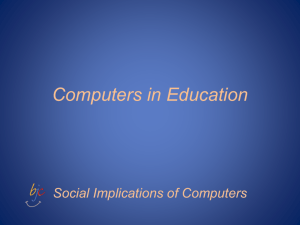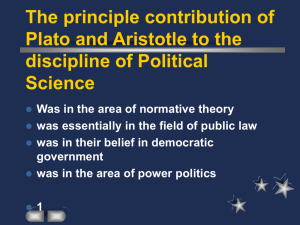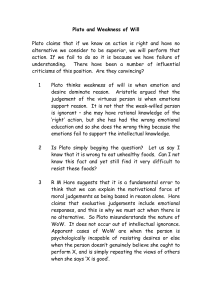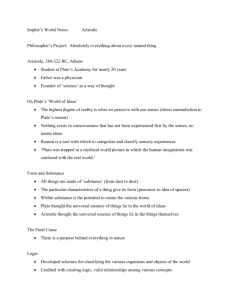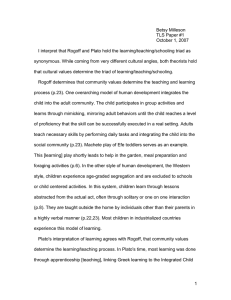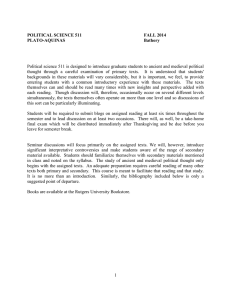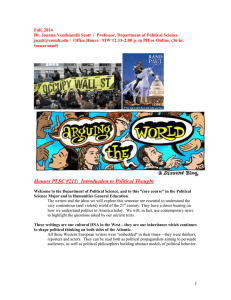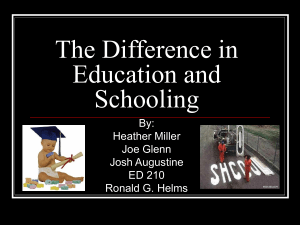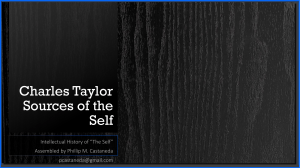Our Common Hope: A History of Teaching and Learning
advertisement
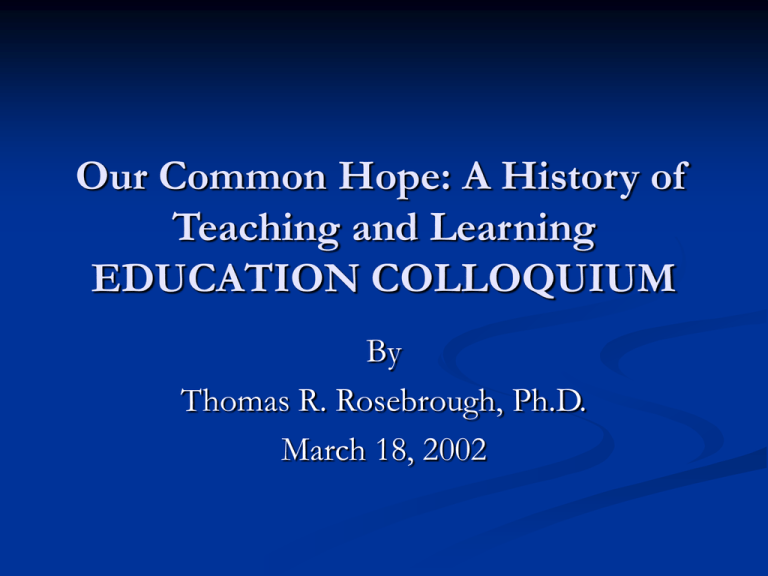
Our Common Hope: A History of Teaching and Learning EDUCATION COLLOQUIUM By Thomas R. Rosebrough, Ph.D. March 18, 2002 A Common Hope Harvard professor, Richard Light, in Making the Most of College (2001), says that the most common hope that students express, when asked about their learning motivations, is that “each class, by its end, will help them to become a slightly different person in some way” (p.47). And, that “faculty who make a difference are those who helped students make connections between serious curriculum and the students’ personal lives, values, and experiences” (p.110). The Goals of Learning What kind of difference do we want to make in our students’ lives? Usually we have three goals, for them to: 1. 2. 3. learn about a subject acquire particular skills become better people It is the dynamic interaction among these three goals that constitutes education. Which is most vital—which should receive priority? History Teaches Us That these questions can have very different answers depending on: who the teacher is what subject or skill is being taught in what historical era or culture the teacher is residing what kind of understanding the teacher and community have concerning the nature of learning. What perspective can the history of education give us as we consider the potential of schooling? Historical Threads Schooling in every era has been concerned with: 1. Attempting to respond to societal needs or thought. 2. Infusing religious or moral values. 3. Seeking to understand the nature of learning. Responding to Societal Needs Sophists of ancient Greece Enlightenment: Descartes and Bacon Rousseau: contrast to Puritan thought Benjamin Franklin: Latin Grammar Schools and Philadelphia Academy Our new American schools in the post-Brown v. Topeka decision Infusing Religious or Moral Values Plato and Augustine Aristotle and Aquinas Martin Luther Calvin and the Puritans The Northwest Ordinance of 1787 “Religion, morality, and knowledge, being necessary to good government and the happiness of mankind, schools and the means of education shall forever be encouraged.” • • • Religion and morality and knowledge Good government and Happiness of mankind Schools and the means of education Understanding the Nature of Learning Isocrates and Plato: methods and philosophy Quintilian Medieval universities Erasmus John Dewey Piaget Brain research and learning Our Common Hope What does history teach us? What can we predict? 1. Change in the types of schooling we offer will occur when society demands it. 2. Technology, as well as competing values systems among different cultures, will drive change. 3. Confusion reigns in contemporary American education. 4. Eclecticism is important in understanding teaching and learning. Just what is education? Theobald (1992) contends that everything already discovered should be called “training,” and that the term “education” should be reserved for unresolved issues and problems. Implication? Inquiry, discovery, and scientific methods of learning must take precedence over expository methods and multiple-choice tests. What will teaching and learning look like this century? Uchida, Cetron, and McKenzie (1996) identified important knowledge, skills, and behaviors needed for the future. Here are a few: Incorporate “marketplace” technology. Promote active vs. passive learning. Commit more time for professional development of teachers. Focus on “real world” projects. Reflect an international perspective in the curriculum. Postmodern Effects Modernist as well as post-modern worldviews have affected the academy, including Christian higher education. Common “weltanschauungs?” Light (2001): social and emotional as well as intellectual. Leonard (1968) propose ideas for the social/moral realm: risk one’s prejudices, coping with problems unforeseen. Meaning and Learning Meaning enhances learning: “Why do we need this?” Neurobiology (Howard, 2000) tells us that the brain resists meaningless patterns imposed upon it. Neurotransmitter, norepinephrine, is released with a strong connecting experience, “telling” the brain to remember. Philosophic Dualisms: Eclecticism Plato: Aristotle: Augustine: Erasmus: Rousseau: Dewey: matter and ideas reason and character Man and God knowledge of words and knowledge of truth society and nature school and society Extraneous Intentions Clifford Williams (2002) in Life of the Mind: A Christian Perspective, writes about how he changed his mind about the purpose of teaching: “What do I really want students to get out of my courses? I promptly got out a piece of paper and started writing. The list of objectives grew to thirteen. I wanted students to become more imaginative, more adventuresome, and more courageous. I wanted them to develop a passion for learning while maintaining habits of self-discipline. I wanted them to think for themselves and make the Christian faith their own. I also wanted them to become more prepared to die” (pp. 43-44). Teaching and Learning Thinking about the nature of teaching and learning: a graphic assignment. Lee Schulman (2002) has created a new “Taxonomy for Learning”: -Engagement -Understanding -Performance -Reflection -Design and Judgment -Commitment Conclusion Fulfilling the potential of our common hope: “What are we trying to accomplish with our teaching?” Lasch (1978) argues for an appreciation of history. Reflection upon historical knowledge: a vital perspective
